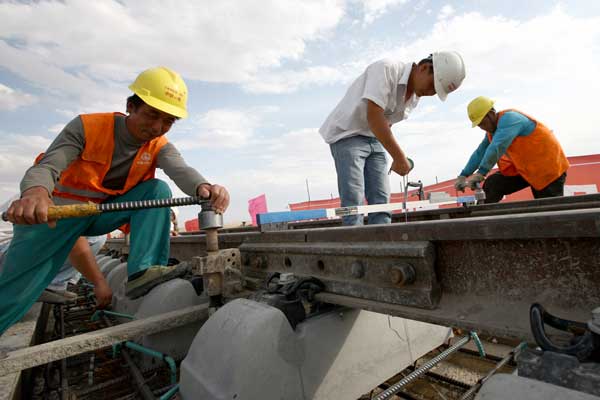

China still has the ability to deal with economic downside risks in the coming months and achieve the growth target of this year, maintaining one of the strongest driving forces in the world, an economist from the International Monetary Fund told China Daily on Thursday.
"The recent slowdown should stabilize and we expect a moderate uptick during the second half of the year as the global economy improves and the rapid credit growth in the first quarter gains traction," said Murtaza Syed, resident representative in China at the IMF.
 |
|
Workers fasten rail tracks in Hami in the Xinjiang Ugyur autonomous region. The IMF predicted in a recent report that China's economy will be able to maintain GDP growth of 7.75 percent and could avoid a "hard landing". POLAT NIYAZ / FOR CHINA DAILY |
Provided strong reforms are put in place, "in the next three to five years, we should see a rebalancing of China's economy that places it on a path of strong and sustainable growth", Syed said.
Despite the moderate cooling down in the first half this year, the world's second-largest economy grew to 24.8 trillion yuan ($4.04 trillion) by the end of June, up 7.6 percent year-on-year.
The economy contributed almost 25 percent of total global GDP growth, "doing the global economy a big favor", according to Syed.
A report from the IMF released on Wednesday said, "China still has significant buffers to weather shocks, but the margins of safety are diminishing."
The "buffers" include using fiscal stimulus and mobilizing foreign exchange reserves and large savings, the economist said.
The report forecast that the economy can maintain growth of about 7.75 percent for the full year, which means a "hard landing" is less possible.
"At this time, there is no need for major stimulus in the economy, which has been accepted by the new leadership," Syed added.
Targeting long-term market-oriented growth, the government pointed to the higher contribution to growth from real consumption than from real gross fixed capital formation over the past two years, strong growth of services relative to manufacturing, rapid increases in urban and rural household incomes, and growth in central and western provinces outstripping that in the more affluent coastal provinces, the IMF report said.
A recent statement from Premier Li Keqiang said that "some ups and downs in the economy are natural and necessary; the objective of policy is to avoid too much volatility".
It can be seen as evidence that policymakers were confident that continuing reforms would achieve the desired rebalancing to a more consumer-based economy, the report added.
Instead of exports, domestic consumption has become the major support to the economy. The services sector will become the most potential driving force in the future, according to Syed.
In the first half, consumption contributed 45.2 percent of GDP, or 3.4 percentage points out of a 7.6 percent year-on-year GDP gain.
Investment was the biggest driver, contributing 53.9 percent to GDP, 4.1 percentage points of the growth, according to the National Bureau of Statistics.
Syed stressed that the heavy reliance on credit and investment to sustain activity is raising vulnerabilities, which will add pressure on the financial sector, local governments and corporate balance sheets.
The IMF estimates that the "augmented" government debt was 45 percent of GDP in 2012, and the "augmented" fiscal deficit was around 10 percent.
He Keng, the former director of the National Bureau of Statistics, said that any fiscal stimulus should be undertaken "cautiously".
Any increase of credit should be done making sure that it can be repaid, in order to limit the risks of local debt problems and the shadow banking system, he said.
Igor Arsenin, an economist at Barclays Capital, said that the downside risks to growth have been reduced at the margin.
"Policy support is likely to come in the form of channeling existing liquidity and providing subsidies to priority areas such as urban infrastructure, affordable public housing and consumption," he said.